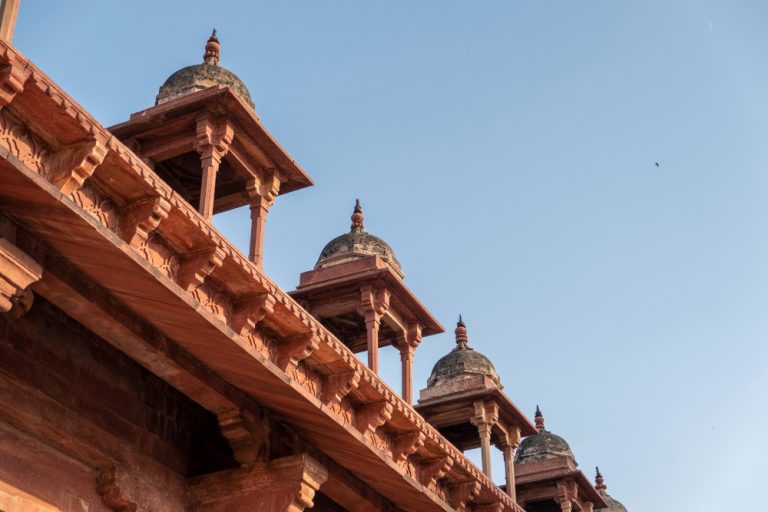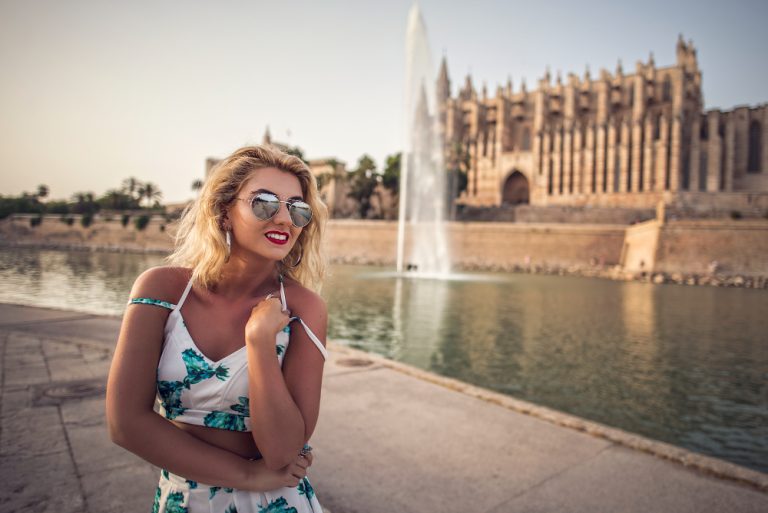Fatehpur Sikri, a UNESCO World Heritage site near Agra, Fatehpur Sikri India is known for its magnificent Mughal architecture, red sandstone monuments, and the aura of an abandoned imperial city. Built by Emperor Akbar in the 16th century, it served as the Mughal capital for a short but significant period. While visitors flock to marvel at its iconic Buland Darwaza, Diwan-i-Khas, and Jama Masjid, there’s a quieter, lesser-known side to this historic site—11 hidden corners that often go unnoticed yet deserve your attention.
If you’re looking to venture off the tourist trail and uncover the secrets of this ancient city, this guide is for you.
1. Hiran Minar: The Tower of the Elephant
Fatehpur Sikri India Tucked away from the main monuments, Hiran Minar is an intriguing and somber memorial to Akbar’s favorite elephant. The cylindrical tower rises about 21 meters and is believed to be either a watchtower or a hunting marker.
The base is adorned with stone representations of elephant tusks, giving it a unique appearance. Because it lies on the outskirts of the main complex, many visitors miss it—but it offers a quiet space for contemplation and striking photos.
2. The Ibadat Khana: House of Worship and Debate
Fatehpur Sikri India Hidden within the imperial complex is the Ibadat Khana, or House of Worship, a small structure that played a major role in Mughal religious history. This is where Akbar invited scholars from various religions—Islam, Hinduism, Jainism, Christianity, and Zoroastrianism—for interfaith dialogues.
Fatehpur Sikri India Though the structure is modest compared to others, its spiritual significance is immense. Standing here gives you a glimpse into Akbar’s inclusive vision and his experiments with Din-i-Ilahi, a syncretic religion he founded.
3. Khwabgah: The Emperor’s Dream Palace
Khwabgah, meaning “House of Dreams,” was Akbar’s personal sleeping quarters. Situated near the Anup Talao, this two-storied building is often bypassed for grander structures like Diwan-i-Khas. But the Khwabgah is rich in subtle details—beautifully carved brackets, internal staircases, and fragments of faded murals.
Its secluded setting offers a peaceful moment away from the crowds, where you can imagine the emperor’s introspective hours under starlit skies.
4. Anup Talao’s Four Pavilions: Acoustic Marvels-
Anup Talao, the ornamental pool at the heart of the royal complex, is typically admired for its central platform. However, its four surrounding pavilions—each once used by different ministers or musicians—have fascinating acoustic properties.
The sound travels in an eerie way across the water, and if you stand quietly, you can almost hear echoes of Mughal court performances. It’s a small sensory discovery that adds richness to your visit.
5. Birbal’s Daughter’s House: Elegance in Simplicity
While most tourists visit Birbal’s Palace, few wander toward the nearby house believed to be of his daughter. It’s a lesser-visited structure with a delicate design—ornate pillars, open verandahs, and intricate stone screens (jalis) that hint at feminine elegance and privacy.
It’s not just a photo-worthy site but also a refreshing reminder of how even smaller buildings were thoughtfully constructed during the Mughal period.
6. Caravanserai Ruins: Glimpse Into the Past
Just outside the fortified gates lie the ruins of the old caravanserai, a rest stop for traders and travelers. These ruins, though partially crumbled, whisper stories of Fatehpur Sikri’s brief yet bustling past as a trade hub.
Few tourists explore this area, making it perfect for those interested in the city’s commercial and social history beyond royal life. It’s also an ideal spot for candid photography amid weathered stone and overgrown paths.
7. Treasury Building: Where the Empire’s Wealth Was Stored
Adjacent to Diwan-i-Aam lies a lesser-noticed building—the Treasury, or Khazana. Its relatively plain exterior belies its past role in storing vast riches of the empire.
Peep inside and you’ll notice strong walls, small windows, and limited entry points—all features designed for security. Though not ornate, it’s a hidden gem for those interested in Mughal governance and administration.
8. Hammam (Royal Bathhouse): A Forgotten Luxury
The royal hammam, or bathhouse, is one of Fatehpur Sikri’s more secretive gems. Hidden behind other structures, it consists of arched chambers, vaulted ceilings, and water channels designed to bring hot and cold water.
Though in partial ruins, the hammam showcases the Mughals’ understanding of luxury and hygiene. Few visitors know of its existence, but for architecture and history lovers, it’s a must-discover site.
9. Girls’ School (Madrasa): A Symbol of Progressive Vision
Not far from the Jama Masjid stands the remnants of an ancient girls’ madrasa, an Islamic school. Commissioned by Akbar as part of his social reform, it reflected his progressive vision of women’s education.
While there are no signboards pointing to it, local guides can help you find the site. Its weathered classrooms and prayer areas offer an important glimpse into the educational practices of the 16th century.
10. Stone Bench of Justice: A Judge’s Seat Under the Sky
Close to the Diwan-i-Aam, there lies a stone bench, often mistaken as part of ruins. However, it served as an outdoor courtroom where lower cases were judged by officials under Akbar’s administration.
The spot may seem unremarkable at first glance, but it represents the grassroots justice system of the Mughal empire—simple, public, and efficient. Sit here, and imagine the bustling crowds once gathered for hearings and verdicts.
11. Secret Escape Passage: The Hidden Tunnel Theory
Local lore speaks of a secret underground passage linking Fatehpur Sikri to Agra Fort, intended as an emergency escape route for the royal family. Though no official evidence has confirmed its existence, remnants of tunnel-like structures in the northern bastions of the complex keep the legend alive.
Guides often share this story during tours, and if you’re lucky, you might be shown one of the potential tunnel entry points. Whether myth or truth, it adds a layer of mystery to the city.
Conclusion: Explore Beyond the Obvious
Fatehpur Sikri’s main monuments are undeniably grand, but its hidden corners reveal a softer, more intricate narrative—one of intellect, intimacy, governance, and daily life. These 11 lesser-known spots offer a richer understanding of Mughal innovation, Akbar’s complex personality, and the social fabric of a city that was once India’s proud capital.
Next time you walk through Buland Darwaza or admire the Diwan-i-Khas, remember to wander off the main paths—you just might stumble upon a piece of forgotten history.
FAQs
1. How long does it take to explore the hidden corners of Fatehpur Sikri?
To explore both the main monuments and hidden corners, plan for at least 4–5 hours. Hiring a local guide can help you efficiently cover offbeat spots without getting lost.
2. Are the hidden areas accessible without a guide?
Some are, but many lack signboards and may be overlooked without a guide. Hiring a certified local guide is highly recommended for a deeper and more informed experience.
3. Is there any extra cost to visit the lesser-known sites?
No, once you’ve paid the entry fee (₹40 for Indians and ₹550 for foreigners), you can access all open areas. However, tipping a local guide is customary and appreciated.
4. Are the hidden areas safe and well-maintained?
Most are safe, but some spots like the caravanserai or hammam may have uneven terrain or loose stones. Wear sturdy shoes and stay cautious in less maintained zones.
5. Can these hidden sites be photographed?
Yes, photography is allowed in most places, but be respectful—especially near religious or sacred sites like Salim Chishti’s tomb or the madrasa. Avoid flash and drones unless permitted.
Also read : Green Tour Paraty: 11 Ways to Connect with Nature on Your Trip





Leave a Comment